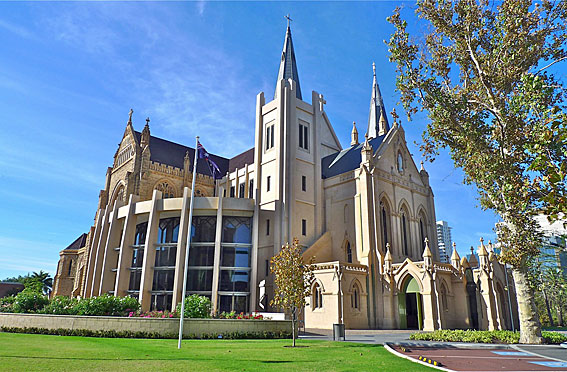
Photo: Trevor Bunning (May 2012)
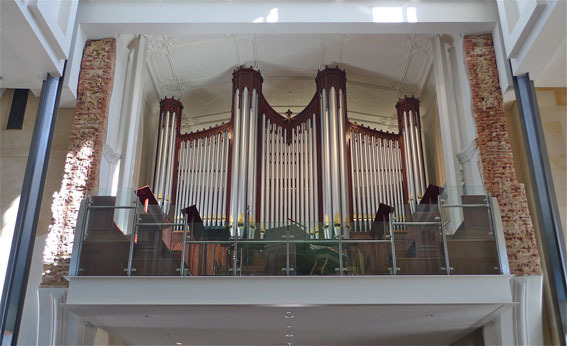
Photo: Trevor Bunning (May 2012)
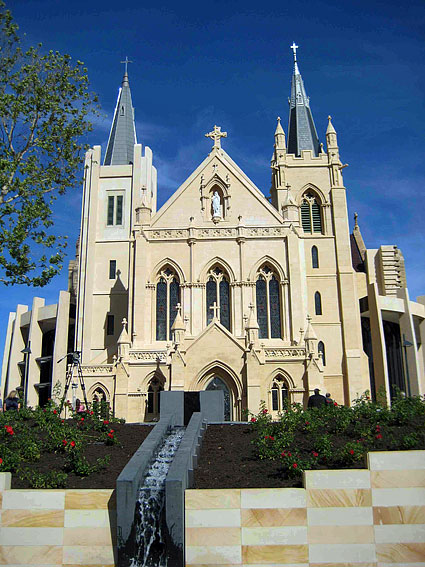
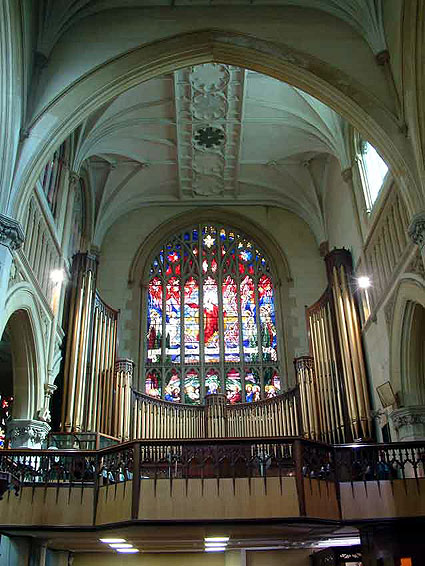
The former organ case in the south transept
The nave of St Mary's Cathedral was commenced under Bishop Serra and Brother Ascione and opened in 1863. The transepts and sanctuary, in a spacious Perpendicular Gothic idiom, were built in sandstone in 1925-26 to the design of Cavanagh & Cavanagh. Michael Cavanagh had been born in Victoria in 1860, studied at the Adelaide School of Art and was studying in England 1887-88, starting his practice in Adelaide in 1891 and moving to Perth by 1898 (the year when he was elected FRIBA) where he was in partnership with his brother James Francis. Their plans to rebuild the nave on the same scale have not been realised although provision can be seen in the side walls for grafting in the new parts of the nave. The 1920s work includes large multi-light windows filled with colourful glass designed and executed by John Hardman and Company of Birmingham. The sanctuary and transepts have elaborate plaster vaulting in a Gothic idiom. The building boasts an outstanding acoustical environment for organ music.
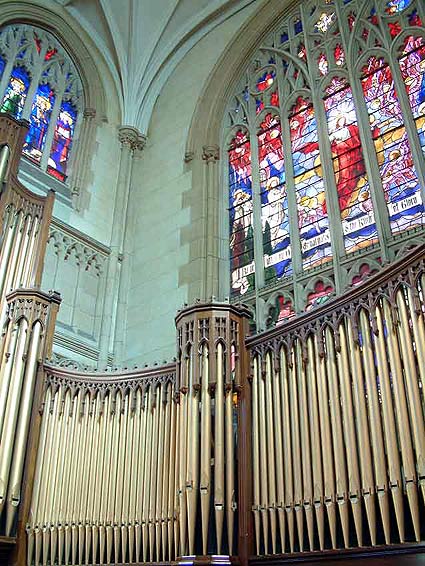
The organ, originally of two manuals, was built in 1910 by J.E. Dodd and was rated by former organist and noted composer Dr C. Edgar Ford as "the finest small organ in Australia", its effect complemented by the astounding acoustic. Its tonal design was almost identical to the organ in Wesley Church, Perth. The instrument was rebuilt and considerably enlarged in 1964 by J.E. Dodd & Sons Gunstar Organ Works, Adelaide. New electro-pneumatic action was installed in place of the original tubular-pneumatic, a new stopkey console supplied, and the organ resited on a new gallery in the south transept behind a new case of Gothic design. There is much borrowing and extension on the Choir and Pedal, but the overall effect of the organ is extremely impressive, with pipework of excellent quality.
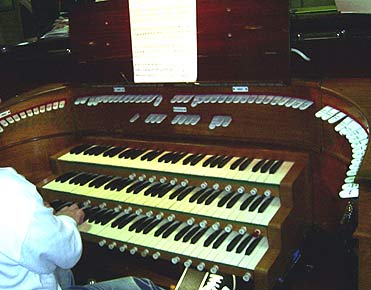
The former organ console when in the south transept
| GREAT Violone Open Diapason Melodic Diapason Clarabel Gamba Gedact Dulciana Principal Gamba Harmonic Flute Twelfth Super Octave Gamba Gamba Mixture 15.19.22 Trumpet Tuba Closed Horn Clarion SWELL Geigen Diapason Hohl Flute Viole d'Orchestre Vox Angelica II Octave Flauto Traverso Super Octave Mixture 15.19.22 Double Trumpet Trumpet Oboe Clarion Tremulant CHOIR Lieblich Gedact Violin Diapason Stopped Diapason Gedact Salicional Octave Flute Salicet Nazard Piccolo Tierce Closed Horn Clarinet Trumpet Tuba Tuba Clarion Tremulant PEDAL Major Bass Open Diapason Violone Subbass Bourdon Quint Principal Bass Flute String Salicional Octave Quint Super Octave Octave Flute Mixture Ophicleide Double Trumpet Trumpet Clarion |
16 8 8 8 8 8 8 4 4 4 2-2/3 2 2 1-3/5 III 8 8 8 4 8 8 8 8 4 4 2 III 16 8 8 4 16 8 8 8 8 4 4 4 2-2/3 2 1-3/5 8 8 8 8 4 16 16 16 16 116 10-2/3 8 8 8 8 5-1/3 4 4 IV 16 16 8 4 |
A * * * A * * * A * A A A B* H G B* * * * * * * * C C C D* E D* F E D F D D G B H H I* A J* D* J I* J A F J I J H* C C C |
* Dodd stops from 1910
D* = ex 1910 Swell
Compass: 61/30
12 couplers
Electro-pneumatic action
Detached stopkey (horseshoe) console
• Building, vol.5, no.26 (12 May 1925), p.1, 158
• Directory of British Architects 1834–1914, updated edition. London: Continuum, 2001, vol.1, p.348
• Complete specification researched by Patrick Elms
From OHTA News April 2007, South Island Organ Company Ltd reports:
In September 2006, SIOC dismantled and packed the 1910 Dodd/1963 Gunstar organ at St Mary's Catholic Cathedral, Perth in preparation for the planned rebuilding of both the organ and the Cathedral. The part of the 1860s nave adjoining the transepts will be demolished to make way for a new transept wide nave that will spaciously integrate the 1930 east end with the 1860s west end. The historic west end including the tower is being retained with the addition of a new suspended choir and organ gallery and matching access tower. The firm will rebuild the three-manual organ to fit the west end position, with a redesigned case, new console and computerised electrical transmission system, and redesigned specification with less stop duplexing and seven additional ranks of pipes in the Dodd style. Completion of the rebuilt organ is planned for early 2009 after the reopening of the Cathedral in 2008.
The new specification will be:
| Great Bourdon Contra Gamba Open Diapason Melodic Diapason Claribel Flute Gedact Gamba Dulciana Principal Orchestral Flute Gamba Twelfth Super Octave Tierce Mixture Trombone Tromba Clarion Swell Sub Octave to Great Swell to Great Swell Octave to Great Choir Sub Octave to Great Choir to Great Choir Octave to Great Swell Bourdon Geigen Diapason Hohl Flute Lieblich Gedact Viole d'Orchestre Voix Celestes Octave Flauto Traverso Fifteenth Mixture Double Trumpet Anglaise Horn Oboe Vox Humana Clarion Tremulant Sub Octave Super Octave Choir (enclosed except Tuba) Violin Diapason Harmonic Flute Stopped Diapason Salicional Vox Angelica Octave Lieblich Flute Salicet Nazard Harmonic Piccolo Tierce Larigot Sifflute Clarinet Closed Horn Trompette Tremulant Tuba Tuba Clarion Sub Octave Super Octave Swell Sub Octave to Choir Swell to Choir Swell Octave to Choir Pedal Major Bass Open Diapason Contra Gamba Subbass Echo Bourdon Quint Octave Principal Bass Flute Gamba Fifteenth Octave Flute Mixture Contra Posaune Ophecleide Trombone Double Trumpet Tromba Clarion Great to Pedal Swell to Pedal Swell Octave to Pedal Choir to Pedal Choir Octave to Pedal |
16 16 8 8 8 8 8 8 4 4 4 2-2/3 2 1-3/5 III 16 8 4 16 8 8 8 8 8 4 4 2 III 16 8 8 8 4 8 8 8 8 8 4 4 4 2-2/3 2 1-3/5 1-1/3 1 8 8 8 8 4 16 16 16 16 16 10-2/3 8 8 8 8 4 4 IV 32 16 16 16 8 4 |
H* A G I A A 15.19.22 * L* L* L* D* D* II 17.19.22 E* * * E* M N* J K * M J K O* N* O* N* C C F (wood) G (metal) A H D H F* I* H A * H 12.15.19.22 * C* C L* E L* L* |
* new pipework (2009)
From Organ Australia, December 2007, John Hargraves (SIOC) writes:
We are rebuilding and transplanting a redundant 2/18 1905 Hobday organ from New Zealand for the east-end chapel of the Blessed Sacrement. The two organs will be integrated with a Peterson ICS-4000 ethernet transmission system enabling them to be played together or separately from either console. Completion is planned for 2009.
From OHTA News January 2010, John Hargraves (SIOC) writes:
ST MARY’S CATHEDRAL, PERTH, WA
a notable Australian organ rebuilt
by John Hargraves and others
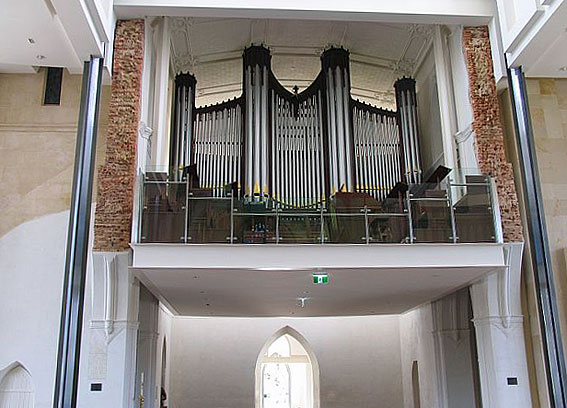
Photo: Bob Elms (2009)
The nave of St Mary’s Cathedral was commenced under Bishop Serra and Brother Ascione and opened in 1863. The transepts and sanctuary, in a spacious Perpendicular Gothic idiom, were built in brick, faced in sandstone, in 1925–26 to the design of Cavanagh & Cavanagh. Michael Cavanagh had been born in Victoria in 1860, studied at the Adelaide School of Art and was studying in England 1887–88, starting his practice in Adelaide in 1891 and moving to Perth by 1898 (the year when he was elected FRIBA) where he was in partnership with his brother James Francis. Their plans to rebuild the nave on the same scale, with two massive west-end towers, were never realized (this was due at first to Archbishop Clunes determination not to go into debt during the depression of the 1930s and later to heritage restrictions on demolition of the remaining 1865 work). The 1920s work includes large multi–light windows filled with colourful glass designed and executed by John Hardman and Company of Birmingham. The sanctuary and transepts have elaborate plaster vaulting in a Gothic idiom. The building boasts an outstanding acoustical environment for organ music.
Tenders were invited for a new organ in 1909 from the two leading organbuilders in eastern Australia: J.E. Dodd, Adelaide and Geo. Fincham & Son, Melbourne. The schemes they submitted (placed in the Cathedral Archives) were for very modest two-manual instruments.
J.E. Dodd’s initial quotation was dated 7 May 1909:
| GREAT Diapason Phonon Melodic Diapason Claribel Dulciana Principal Suabe Flute Super Octave SWELL Geigen Diapason Hohl Flute Viol d’Orchestre Octave Flute Traverso Oboe Tremulant PEDAL Bourdon Bass Flute COUPLERS Swell to Great Swell Sub Octave Swell Super Octave Great to Pedal Swell to Pedal Melody Coupler |
8 8 8 8 4 4 2 8 8 8 4 4 8 16 8 |
PISTON MOVEMENTS
Great Organ "piano"
Great Organ "mezzo-forte"
Great Organ "forte"
Great Organ "Negative=Release"
Swell Organ "piano"
Swell Organ "mezzo-forte"
Swell Organ "forte"
Swell Organ "Negative=Release"
SFORZATO PEDALS
Great Organ "fortissimo"
Swell Organ "fortissimo"
Grand Organ "fortissimo"
PNEUMATIC ACCESORIES
Balanced Sforzando pedal
Balanced Crescendo pedal
21 Button Registration Indicators
Sforzando Indicator
SUGGESTIONS:
I strongly advise the Organ being built so that it can be added to at some future time. I would suggest that the Great Organ be prepared for 3 stops. The Swell for 5 and the Pedal for one or more. The following is what I suggest, and the price if put in the Organ while it is being built.
| GREAT SWELL PEDAL |
Bourdon Tromba Mixture Lieblich Gedackt Cor Anglaise Voix Celeste Vox Humana Mixture Open Diapason Ophecleide |
16' 8' III 16' 8' 8' 8' III 16' 16' |
(£35) (£30) (£25) (£35) (£30) (£28) (£28) (£25) (£60) (£35) (from Tromba) |
Any of the above stops can be prepared for while the Organ is building at a cost of Ten pounds (£10:-:-) each, or any one Stop can be added to the Organ for the price named. In the event however, of the whole of the above stops being inserted during the construction of the Organ, over and above the scheme submitted, I am prepared to make a reduction on the whole of Thirty-seven pounds (£37:-:-)
George Fincham & Son submitted their proposal on 17 May 1909:
| GREAT Open Diapason Claribel Dulciana Principal Clear Flute Trumpet SWELL Bourdon Open Diapason Lieblich Gedact Viol d’Orchestre Viox [sic] Celeste Octave Oboe Tremulant PEDAL Open Diapason Bourdon Bass Flute COUPLERS Swell to Great Great to Pedal Swell to Pedal |
8 8 8 4 4 8 16 8 8 8 8 4 8 16 16 8 |
gvd.bass gvd.bass TC derived |
4 pneumatic combination pistons to Great Organ
4 pneumatic combination pistons to Swell Organ
Compass: 58/30 and with tubular-pneumatic action
J.E. Dodd’s final scheme, and that which was built, dated 25 October 1909, was:
| GREAT Lieblich Bourdon Open Diapason Melodic Diapason Claribel Lieblich Gedact Salicional Principal Flute d’Orchestre Super Octave Tromba Clarinet SWELL Lieblich Gedact Geigen Diapason Hohl Flute Viole d’Orchestre Viole Angelica II Octave Flauto Traverso Mixture Anglaise Horn Oboe Vox Humana Tremulant PEDAL Open Diapason Major Bass Sub Bass Bourdon Principal Trombone COUPLERS Swell to Great Swell Sub Octave Swell Super Octave Great to Pedal Swell to Pedal |
16 8 8 8 8 8 4 4 2 8 8 16 8 8 8 8 4 4 III 8 8 8 32 16 16 16 8 16 |
(harmonic treble) TC (acoustic: derived) (from Great) (from Swell) (from Great) (treble from Great Tromba) |
PISTON MOVEMENTS
Great Organ "pianissimo"
Great Organ "piano"
Great Organ "mezzo-forte"
Great Organ "forte"
Swell Organ "pianissimo"
Swell Organ "piano"
Swell Organ "mezzo-forte"
Swell Organ "forte"
SFORZATO PEDAL MOVEMENTS
Great Organ "fortissimo"
Swell Organ "fortissimo"
Grand Organ "fortissimo"
This organ, opened on 30 May 1910, was rated by former organist and noted composer Dr C. Edgar Ford as “the finest small organ in Australia”, its effect complemented by the astounding acoustic. Its tonal design was almost identical to the organ in Wesley Church, Perth. The instrument was rebuilt and considerably enlarged in 1964 by J.E. Dodd & Sons Gunstar Organ Works, Adelaide. New electro–pneumatic action was installed in place of the original tubular–pneumatic, a new stopkey console supplied, and the organ resited on a new gallery in the south transept behind a new case of Gothic design. The instrument, whose full specification is on the OHTA website, has been visited during the two OHTA conferences held in Western Australia and became widely known in the 1960s and 1970s through the superlative playing of Annette Goerke in the ABC programme ‘Organists of Australia’.
The Cathedral now consists of two historical (1863 west end and 1920s east end) architectural spaces cleverly linked by the new Peter Quinn nave, to make a uniquely satisfying space incorporating a new crypt (with facility rooms, mortuary chapel, car park) and access tower and has immediately shown itself to have extremely good acoustic properties (six seconds reverberation) and exciting musical possibilities.
The Dodd organ has been relocated from its 1964 transept position to a new suspended choir gallery at the west end where it was originally housed. A second organ, built by Arthur Hobday, has been provided for the east end of the Cathedral and is interconnected to the Dodd. The Hobday organ was built in 1905 for Newtown Methodist Church Wellington, NZ and has been in SIOC storage for 25 years waiting for a worthy project. As their builders both trained with George Fincham in Melbourne it is fitting that these two organs should end up working together in such a rewarding space.
The South Island Organ Company has tried to raise the heritage profile of the original and contributing builder’s work as much as possible. They both now have all their original sounds fairly faithfully within the whole, but not at the original pitch which is a pity (both were originally high pitch) but the needs of Cathedral music transcended this (the Dodd pitch was lowered in 1964). The firm has of course made the necessary tonal adjustments to maintain the original tonality. Both of the new consoles have references to the originals in the keyboard and stopknob design. The Hobday case is closely modelled on the original and uses the original chests above the impost, except for the back which is all new as the original was in a chamber. The lower panelling looks original but is all new as it is higher because the divisional layout is now Swell above Great instead of behind Great and the console is detached instead of attached. SIOC used the maximum footprint that was allowed and this issue nearly scuppered the whole idea of using the Hobday. The whole organ has been winded from a contemporary restored double-rise reservoir (the original was too large for the new footprint) and restored and reused the original slider chests and facade chests. The original attached console was destroyed in a c.1960 electrification. The organ became redundant in the early 1980s when the Church was demolished and the site commercially developed including a new chapel that was too small for it.
With the Dodd organ, most of the elements of the 1964 Gunstar case have been reused but in an entirely new configuration. Sections have been rearranged in order and height and width (panelling, posts and pipes) to make it fit the new space in a meaningful way (width and height are both considerably less). The internal layout of the organ is similar to 1964 (Swell – Great – Choir side-by-side on the same level) but the Pedal is disposed differently with the Major Bass now at the back instead of the bass end and the Subbass in front of the Swell instead of behind the Great. The Tuba trebles are above the Great, the basses in front of the Choir and 32ft section behind the Great. The Great Tromba trebles are in front of the Great and the basses including the Trombone in front of the Choir. SIOC has restored and reused the original Dodd double-rise reservoir and slider chests, pedal chests and swell box though with new vertical shutters and extended depth. The original case and detached console were destroyed in 1964.
The Grand Organ blower is the old 1964 three-stage “Discus” fan by Watson & Watkins relocated above the lift shaft in the new tower. It draws ambient air through a cooling coil and delivers it to the organ through the ceiling in two ducts (high and low pressure). The organ is humidified through the wind-chest ducting with the same company’s equipment. Blower cooling starts automatically when the choir air-conditioning is switched on. The Cathedral nave is also air-conditioned through the floor cavity to a height of 2.5 metres. The floor is timbered in Jarrah except for the four Chapels which are mosaic. The old sanctuary is now the Blessed Sacrament Chapel.
The new organ gallery which seats 40 choristers, 10 instrumentalists and conductor stops about two metres short of the west end with an elliptical six metre high false wall that protects the organ from the heat of the west windows and allows its sound to go freely down the back to the narthex/baptistry underneath. The gap also allows the windows to be viewed from below and light the whole area. The architectural device of suspending the platform from the ceiling without it touching the walls has had a most beneficial effect all round and will enable the organ to be used for larger musical events than the gallery can accommodate by utilising the narthex space for a large choir/orchestra. It is doubtful that this possibility was envisaged by the architect who was responding to heritage requirements, but musicians will soon find the potential rewarding.
GRAND (WEST GALLERY) ORGAN
| GREAT Bourdon Contra Gamba Open Diapason Melodic Diapason Claribel Flute Gedact Gamba Dulciana Principal Orchestral Flute Gamba Twelfth Super Octave Tierce Mixture 15.19.22 Trombone Tromba Clarion Swell to Great Choir to Great Chancel Organ to Great SWELL Bourdon Geigen Diapason Hohl Flute Lieblich Gedact Viole d’Orchestre Voix Celestes II Octave Flauto Traverso Lieblich Flute Fifteenth Mixture 17.19.22 Double Trumpet Horn Trumpet Oboe Vox Humana Clarion Tremulant Sub Octave Unison Off Super Octave Chancel Organ to Swell Choir to Swell CHOIR Violin Diapason Harmonic Flute Stopped Diapason Salicional Vox Angelica Octave Nason Flute Salicet Nazard Harmonic Piccolo Tierce Larigot Sifflute Trompette English Horn Clarinet Tremulant Tuba Sub Octave Unison Off Super Octave Swell to Choir Chancel Organ to Choir PEDAL Major Bass Open Diapason Sub Bass Contra Gamba Echo Bourdon Quint Octave Principal Bass Flute Fifteenth Octave Flute Mixture 12.15.19.22 Contra Posaune Ophicleide Trombone Double Trumpet Tromba Clarion Great to Pedal Swell to Pedal Choir to Pedal Chancel Organ to Pedal |
16 16 8 8 8 8 8 8 4 4 4 2-2/3 2 1-3/5 III 16 8 4 16 8 8 8 8 8 4 4 4 2 III 16 8 8 8 8 4 8 8 8 8 8 4 4 4 2-2/3 2 1-3/5 1-1/3 1 8 8 8 8 16 16 16 16 16 10-2/3 8 8 8 4 4 IV 32 16 16 16 8 4 |
H A G I A Q A L L L D D TC D E E E M N J K TC M J K O N S O N C F G H A D H F I H Y H P C C L E L L |
1910 1964 1910 1910 1910 1910 1964 1964 or earlier? 1910 1910 1964 2009 1910 1964 1910 revised 2009 1910 1910 revised 1964 as Tuba & 2009 1910 1910 1910 1910 1910 1910 1910 1910 1910 1910 1964 1964 & 2009 1964 & 2009 1910 2009 1910 2009 2009 (for Chancel Organ use) (enclosed except Tuba) 1964 2009 1964 1910 2009 1964 1964 1910 2009 2009 1964 2009 2009 1964 1964 1910 2009 1910 1964 1910 1964 1910 1910 1910 1910 1910 1964 & 2009 1964 revised 2009 with new rk 4 2009 2009 1910 1964 & 2009 1910 1910 |
Pipework on the Great and Swell Organs is placed on two 11-rank 58-note Dodd slider chests (with top note extensions) together with unit chests. Pipework on the Choir Organ is placed on a four-rank 61-note slider chest together with unit chests. The Ophicleide/Tuba rank is voiced on 300mm wind pressure, with 180mm for the Trombone/Tromba unit and Swell Trumpet 16 8 4 units. The Choir is on 130mm. The rest of the Swell, Great and Pedal is on the original double-rise reservoir at 105mm.
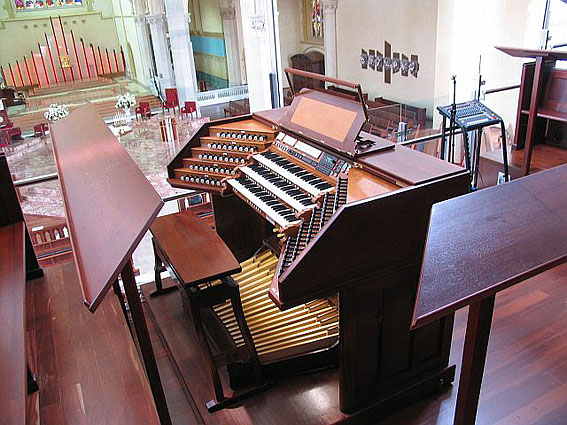
Photo: Bob Elms (2009)
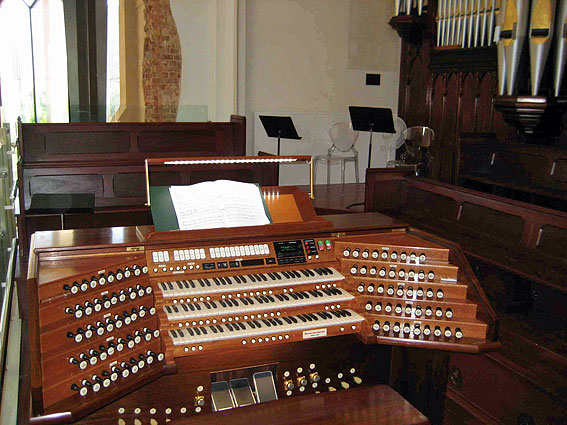
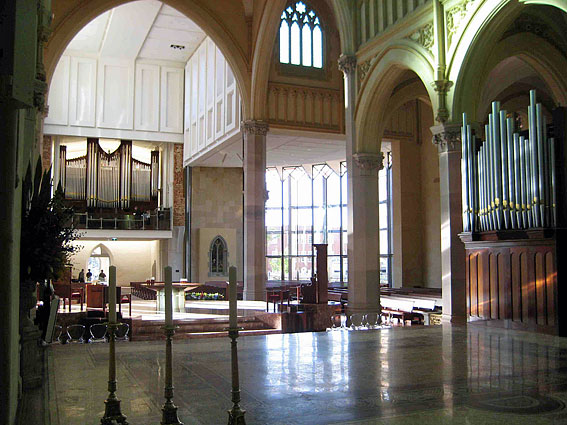
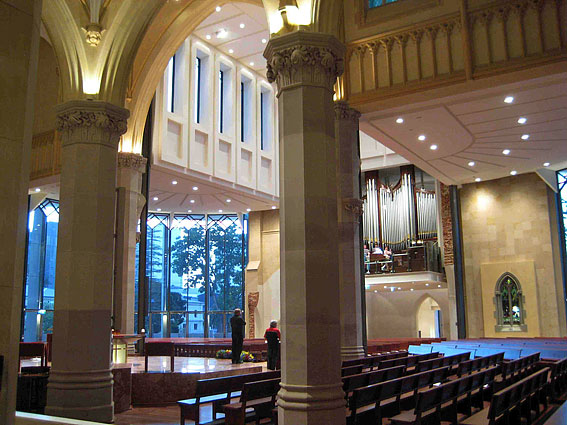
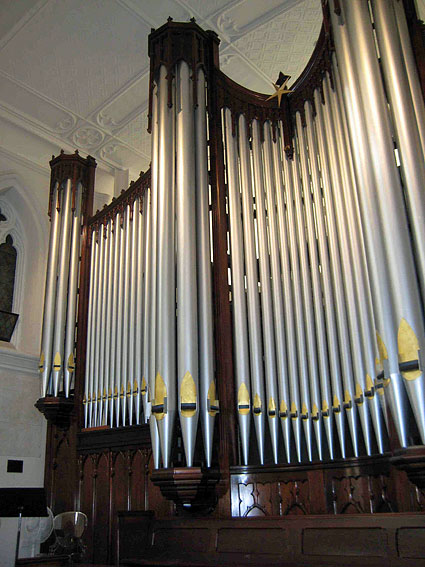
Photos of rebuilt organ above: Colin van der Lecq (2010)
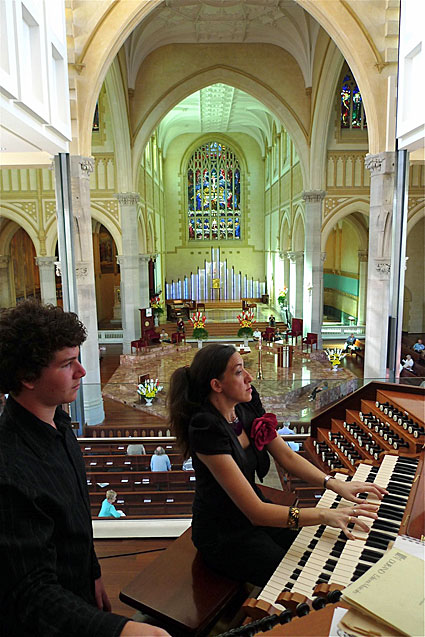
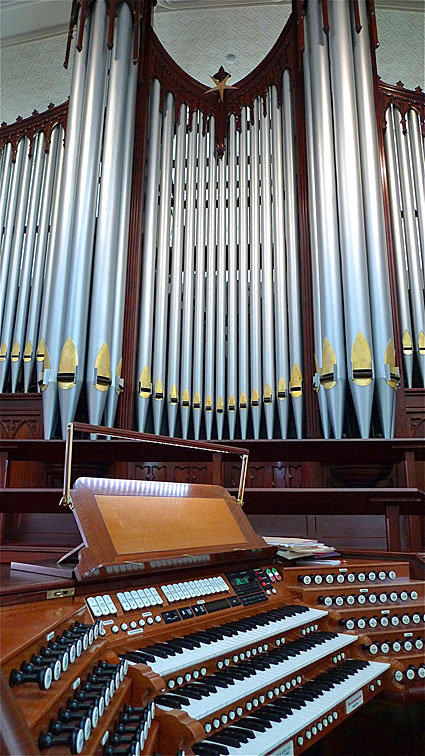
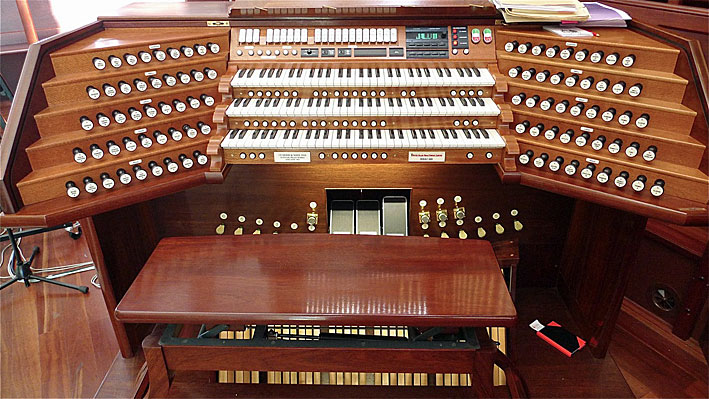
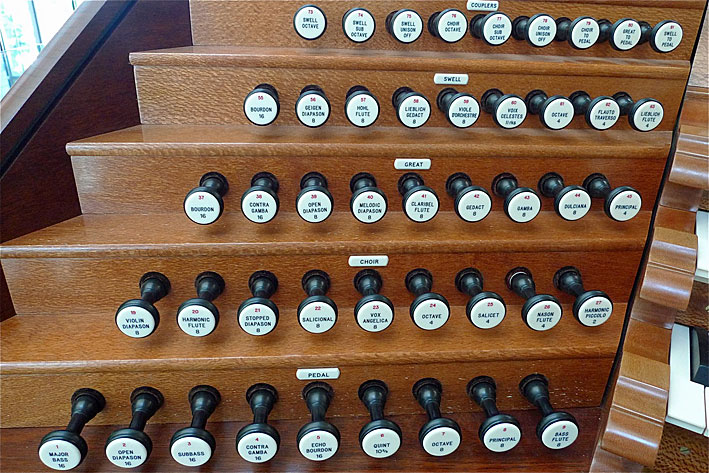
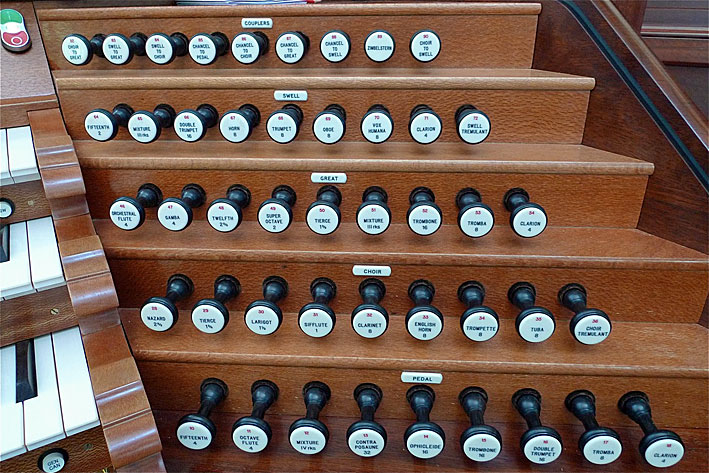
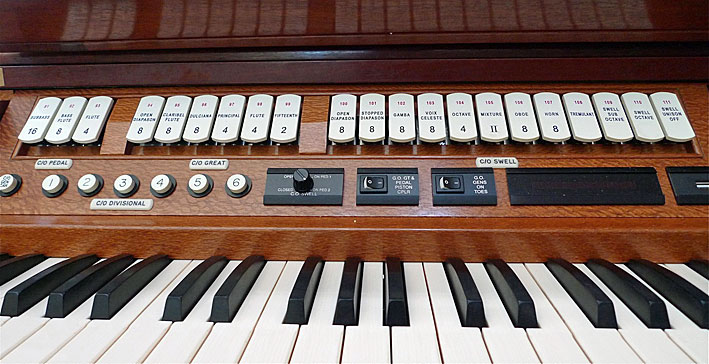
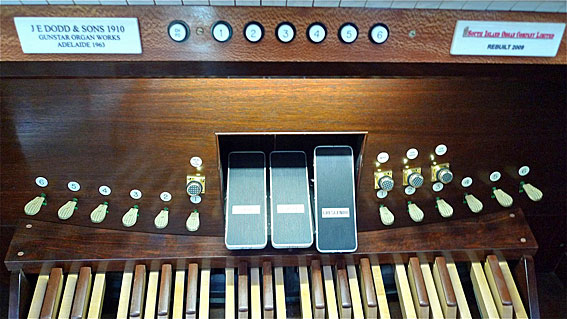
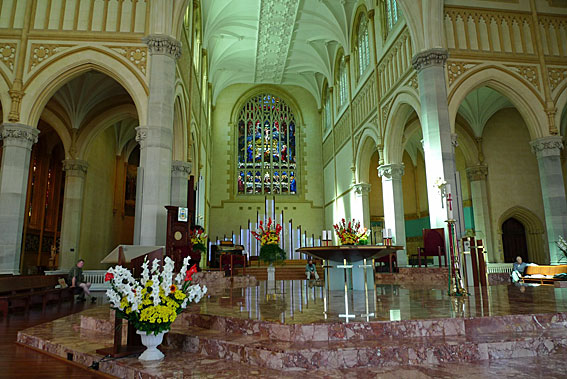
Photos above: Trevor Bunning (May 2012)
CHANCEL ORGAN
| GREAT Open Diapason Claribel Flute Dulciana Principal Flute Fifteenth Swell to Great SWELL Open Diapason Stopped Diapason Gamba Voix Celeste Octave Mixture II Horn Oboe Tremulant Sub Octave Super Octave PEDAL Sub Bass Bass Flute Flute Great to Pedal Swell to Pedal |
8 8 8 4 4 2 8 8 8 8 4 II 8 8 16 8 4 |
2009 a few original pipes survive TC 2009 revised 2009 2009 (Croft 1964) (pipes inscribed A Hobday, H T Launceston 1887) Z Z Z 2009 |
The Chancel Organ has its own two-manual console and duplicate drawstops on the Grand Organ console. In G/O Master Mode these stops play as one division from the Grand Organ console on whichever manual they are coupled to. The manual pipework is placed on two 56-note slider chests with top note extensions.
The Grand Organ is fitted with an ICS4000 capture system with 256 level piston memories. The Chancel Organ is fitted with an ICS4000 capture system with 128 level piston memories.
The two organs filled two 40ft high cube shipping containers and the shipment weighed 19 tonnes net.
The consoles and casework of both organs were French polished and waxed with a mixture of Carnauba and beeswax. The console timber is WA Jarrah and the lighter panels are NZ Rewarewa (similar to Australian Silky Oak or English Lacewood).
The chancel organ Hobday case was originally made of Rewarewa and Kauri but the lower panel frames are now of Jarrah with Rewarewa infills. The impost rail is NZ Kauri and the plinth under it is dark stained Rewarewa. Parts of the Rewarewa that couldn’t be used on the case were saved for both console stopjambs as the figure in the grain was so outstanding. All the wooden pipes in the Hobday are made of Kauri. The facade pipes of the Hobday were originally diapered but this had been silvered over before the instrument came to SIOC. The Cathedral was encouraged to restore it but they wanted both organs to have silver pipes with gilded mouths. However, photographic and paper patterns of the diapering was made for posterity after stripping the pipes as the pattern had etched itself into the zinc metal. The case of the Dodd is made of Australian hardwood stained to look like Jarrah.
The Swell Viole Angelica II 8 was originally one rank at pitch and the other tuned flat but is now (to accommodate the pitch change) one rank at pitch and the other tuned sharp and consequently renamed Voix Celestes II 8. The new Choir Vox Angelica 8 is tuned flat to make up for the change in the Swell and paired with the Salicional 8 provides an interesting tonal contrast as they are much broader in scale and tone than the Swell strings which are typically narrow. The renamed Swell Horn 8 is a conventional Horn and is the same set of pipes originally named Anglaise Horn 8 (a peculiar Dodd quirk) but the renamed English Horn 8 in the Choir, introduced in 1964 as a Closed Horn 8, is a beautiful Cor Anglais with narrow conical resonators topped by double-coned bells.
The Great Open Diapason 8 and Melodic Diapason 8 could equally be named Open Diapason 1 and Open Diapason 2. Both are of heavy roughcast metal voiced with considerable power as are all the original Dodd principal toned ranks. The Swell Oboe 8 has large bells (and corresponding presence) from tenor C and a conical bassoon bass in the bass octave. The Pedal Trombone has large leathered shallots giving it a very useful weight and smoothness which gathers brilliance as it ascends in its Tromba range. The 1964 Choir Trompette 8 is a fiery toned reed with open French shallots and has enough power to light up the full organ or the Tuba. The new Tuba is a typical English example with enough power to dominate as a solo rank yet surprisingly still has a useful climactic function in a really full organ chorus. Of course it is not needed for the organ to give a satisfying tutti as any one of the three divisions can do that unaided.
The Pedal Contra Posaune extended from the Tuba is the first example of a full-length high pressure 32ft reed in WA and underpins the full organ in grand style. The workmen in the cathedral heard plenty of the “jackhammer” as they called it during the voicing period and even the Cathedral project administrator could not imagine how such a sound could be a part of a musical instrument. The Choir division has been thought of as an Orchestral rather than an Echo though it fulfils both roles. As the organ is only one division deep the balance of similar ranks in each division is not greatly different so many possibilities for trio registrations are possible. The Great Tierce is a string toned rank that gives a spicy tang to the chorus. The Choir Tierce is a stopped flute as are the Nazard and its extension the Larigot, so Cornet-type registrations on the Great have a very different colour from those on the Choir. The Choir 1964 Stopped Diapason rank is of exceptionally large scale wooden pipes of very beautiful effect and the new Choir Harmonic Flute rank complements it with contrasting orchestral colour.
The Swell Bourdon was deliberately moved back to that division to recreate the Dodd tonal palette, where because of its small scale it provides perfect gravitas and useful contrast at 8 and 4ft pitches to the original open flutes. 16ft manual flue tone can be freely used throughout the organ with little risk of heaviness, such is the liquid acoustic of the room. Although both Great and Swell have only 3 rank Mixture stops these provide all the brightness necessary for the pleno and light up the reed choruses convincingly. Although both Great and Swell reed choruses are extended the separate Horn 8 fills out the Swell, and the Great Tromba is sufficiently sonorous to overcome any practical perception of weakness. The new Swell Vox Humana 8 beautifully reinstates the original missing Dodd rank and does all that one would expect of it.
Of the end result, John Hargraves writes: We are absolutely stoked with the sound and appearance of the organs. The Dodd’s individual sounds are recognisable close up but the effect in the building is quite different. I would describe the overall sound as arresting but not oppressive even though it is immensely powerful. It is quite difficult to make the organ sound as thick as one might expect; even the most turgid registrations make musical sense. The 8 or 16ft Pleno sound rich and clear and with the Pedal Trombone underneath it is great for a Bach prelude and fugue. The organ seems perfectly at home in a very wide repertoire and playing styles. The Hobday is a beautiful match for its position and role to support smaller services and concert events and has a more refined sound than the Dodd. It fills the room without effort and I would describe it as engaging. Obviously this says as much (maybe more) about the room as the organs.
Colin van der Lecq, who has known the St Mary’s organ for many years and worked on its installation, states: To my ear, the tonal improvements to the Grand Organ have been dramatic. I think my aural memory of the 1964 setup is reasonably secure and thinking back to the soundscape of that organ, the 2009 organ has acquired far more clarity and refinement. I thought the majority of the 1964 sound was 'tubby' and boring, whereas now I feel the sound has regained character and focus. This is all enhanced by the superb acoustic properties of the building: the reverberation time has I'm sure increased too. I am also constantly amazed at how well the tonal palette works, making the various schools of organ literature sound extremely convincing.
The Chancel Organ has to be one of the best small organs in WA. It is positioned in a part of the building which appears to have the best acoustics for organ tone - slightly broader and more liquid than the rest of the building. The Hobday produces very beautiful unforced sounds. While built at a similar time to the Dodd, its tone is different enough to provide an interesting contrast.
The above article includes material supplied by John Hargraves, of the South Island Organ Company Ltd, David Shield, John Maidment, Colin van der Lecq and the Cathedral Director of Music Jacinta Jakovcevic, from the Cathedral Archives.
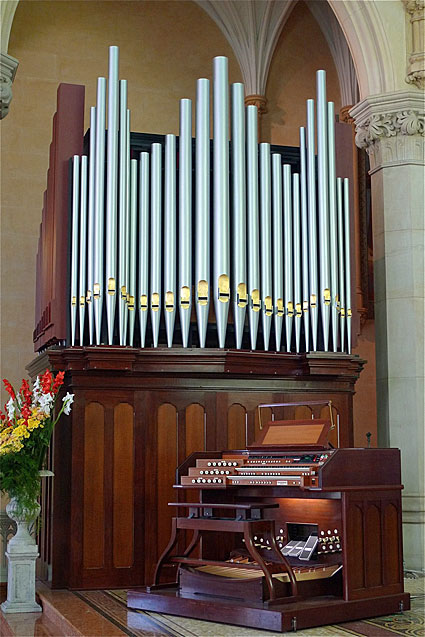
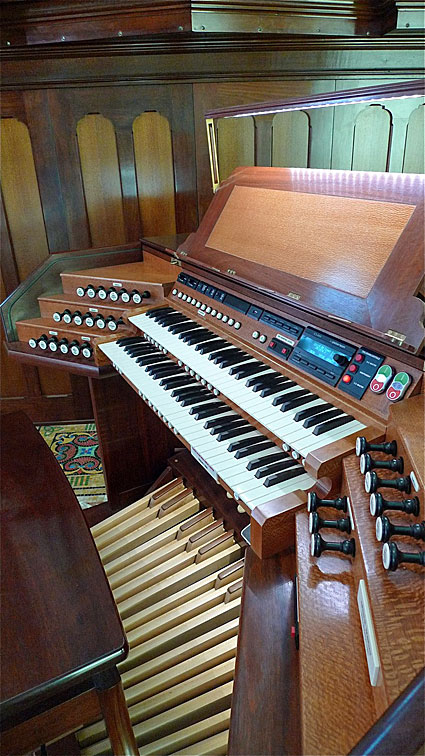
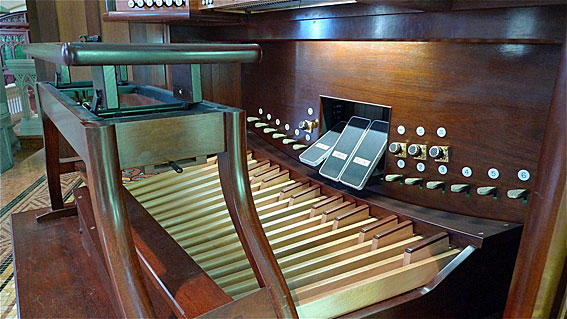
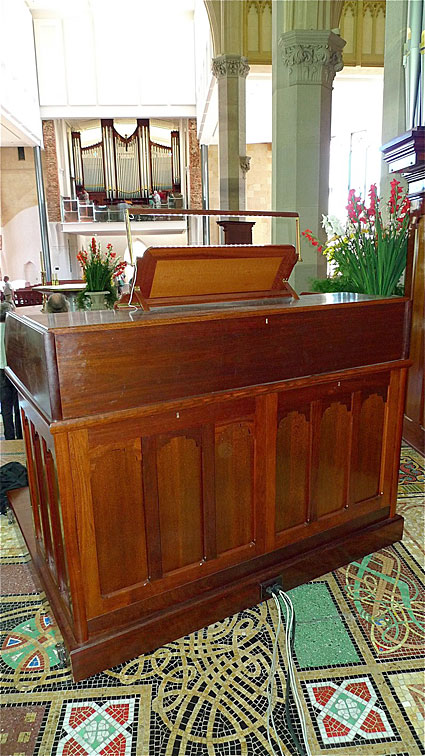
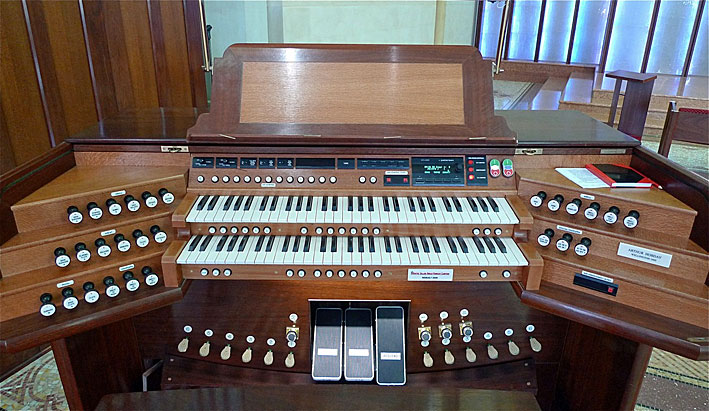
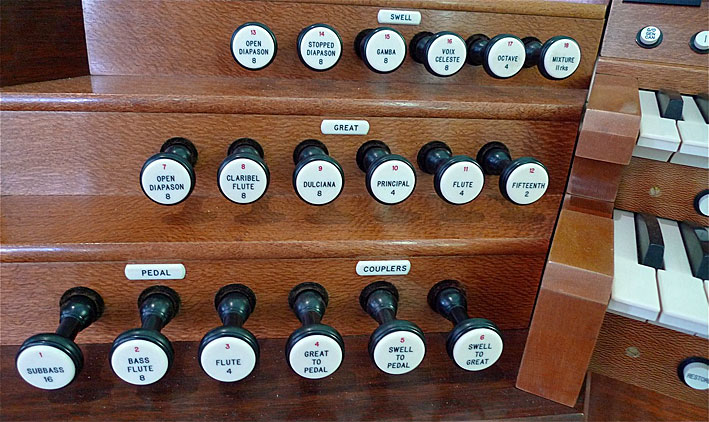
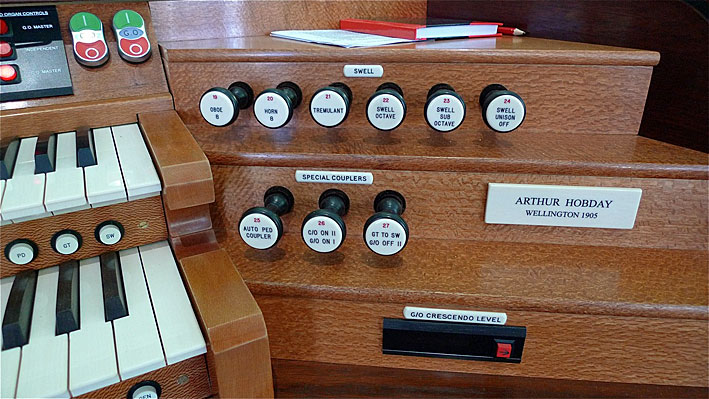
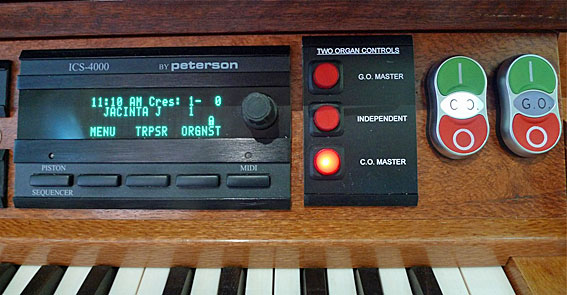
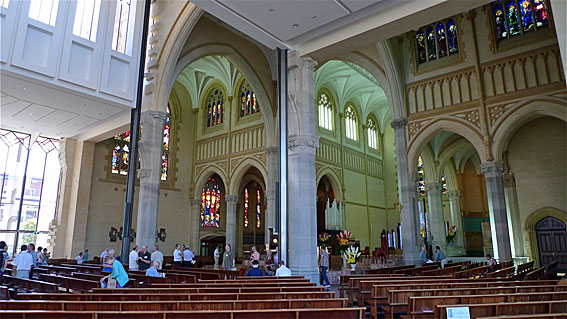
Nine photos above: Trevor Bunning (May 2012)
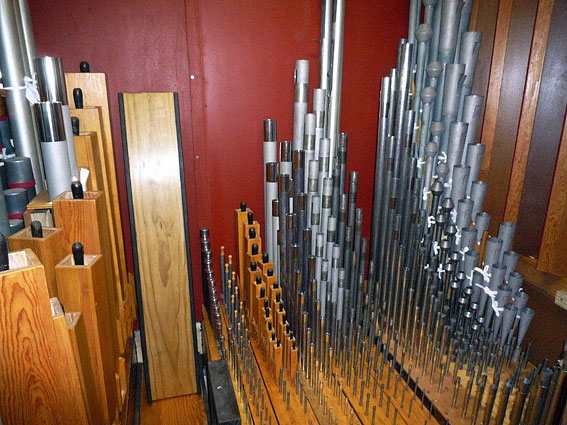
Choir Organ (Photo: John Hargraves)
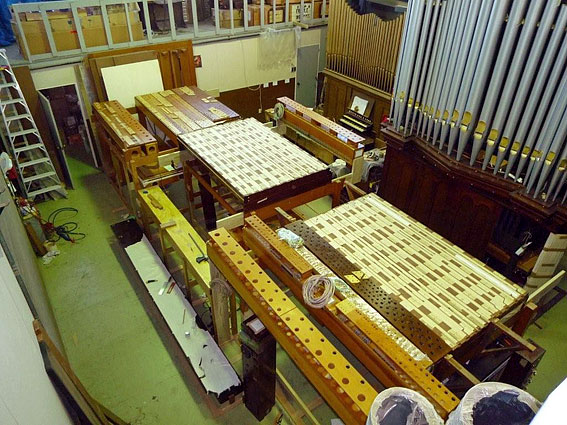
Photo taken in factory (John Hargraves)
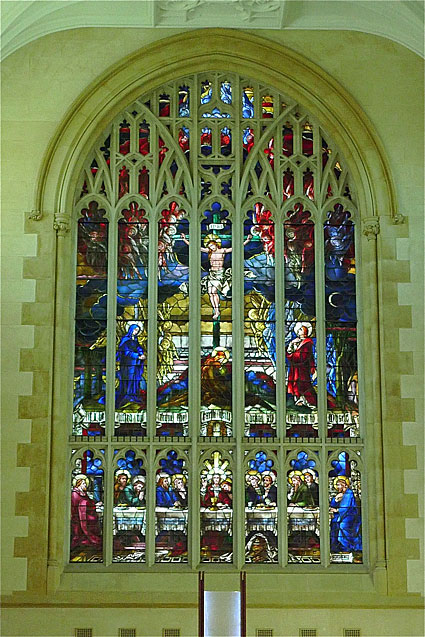
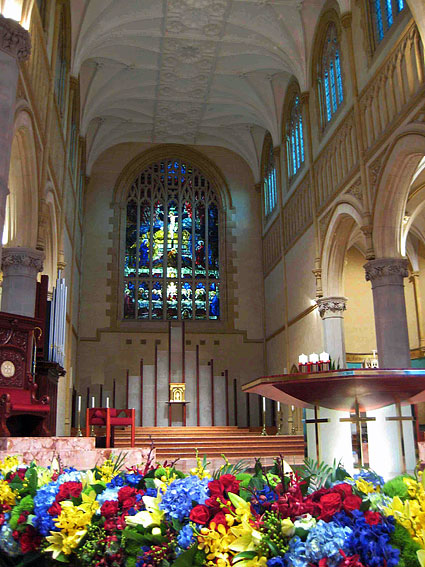
Photos of rebuilt organ (unless otherwise stated): Colin van der Lecq (2010)